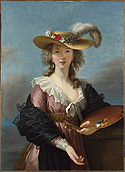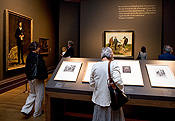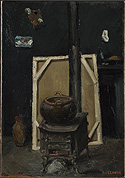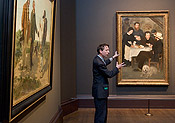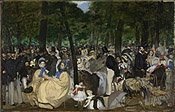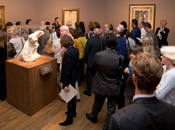The browser will either open the file, download it, or display a dialog.
|
Rebels and Martyrs: The Image of the Artist in the Nineteenth Century |
||||||
|
Rebels and Martyrs: The Image of the Artist in the Nineteenth Century did not draw crowds to the Sainsbury wing of the National Gallery of Art, London (28 June-28 August 2006). The quality of the works would have appealed to a wide audience as the curators had gathered important paintings, prints, and sculpture from leading international collections. The exhibition's theme was also engaging and suggested a show that would explore dominant myths of nineteenth-century art. Perhaps the advertising could have been more appealing: banners displaying half of Abel de Pujol's face from Self Portrait, 1806 (cat. 7), gave an image of classical beauty and academic precision from the early nineteenth century that seemed in tension with the exhibition's subject.1 A comparable fragment of Courbet's agitated Self Portrait (Private Collection; hors catalogue) would have been more compelling. As a late addition to the exhibition, it was not available for either publicity or the publication. Courbet's disheveled persona and genius guise did, however, ensnare viewers as the centerpiece of the second room. The downfall of the exhibition was neither the publicity nor the caliber of the works on display. Where it failed was in its methodological approach: the exhibition presented leading mythologies of nineteenth-century art without questioning their consequences. | |||||
| The exhibition's seventy-three works were organized by seven themes and ranged from an early, despondent Self Portrait by Barry, an oil on paper of circa 1780, to as late as Schiele's provocative ink and black crayon drawing from 1912, Self Portrait as a Nude (cat. 71). These two works convey a sub-theme of inner self-questioning that reemerges throughout the exhibition. None of that interiority is present, though, in the first room devoted to the theme Hero of the Establishment. Here, self portraits by Reynolds, Vigée Le Brun (fig. 1) and Roslin, as well as Eckberg's portrait of Thorvaldsen present the lavish clothing, medals, and social status select artists attained and used for further self-promotion. While each work is skillfully rendered and a pleasure to behold, they depict neither rebels nor martyrs, but rather embody the structures against which others resisted or sought acceptance on their own terms. | ||||||
| The four large-scale, self-confident portraits in Hero of the Establishment juxtapose well with the more apprehensive subjects of the next theme, Romantic Hero. Here the modest scale, tentative outward glances, and even media in which the works are executed evoke the outsider status the artists held or, in some cases, sought to exploit. As the outer appearances of self-confidence and fashionability disappear, the viewer is invited into the artists's inner psychological sanctuary. In Self Portrait at the Easel (cat. 12) Janssen presents himself as a prematurely stooped figure. Only one small corner of canvas suggests his work at the easel, while his muscular yet emaciated, bare torso is staged before a narrow bed against bare walls that conveys the simplicity of his daily life. Janssen's refined technique and purposeful pose accurately frame his expression as one of inner strength and calm resolve. Fuseli's Self Portrait Study (cat. 6) is considerably more tentative. In this economic black and white chalk drawing, Fuseli successfully reveals an astonishing degree of self-doubt. Objective distance seems to be possible only in the hands of an artist other than the subject, as is the case in Kersting's painting Friedrich in his Studio (cat. 9). Friedrich appears isolated in the corner of his studio, studying the work on his easel. Bathed in light, Friedrich looks calm and enjoys a certain privilege studying the work, a position Kersting denies the viewer who sees only the blank back of the painting and its stretcher. We are left to imagine the peaceful and likely symbolic scene that Friedrich considers. | ||||||
| From the subject of the Romantic Hero, the exhibition shifts to consider origins and the theme of the next room is Romantic Myths. Here, I must admit a bias as the author of a study of Rembrandt and the nineteenth-century.2 The artistic persona critics molded for Rembrandt made him the principle prototype for non-conformist, anti-traditional artists in the nineteenth century. In keeping with the Rembrandtmania that flooded museums in the four-hundredth anniversary of the Dutch artist's birth, he is surprisingly absent. Rembrandt's paintings were the subject of a special display in the National Gallery's permanent collection but his absence is inexplicable in this exhibition. | ||||||
| The selection of works on the subject of Old Master veneration is otherwise quite successful, although narrow in its scope. Two works by Révoil and Moreau present a talented young Giotto drawing (cats. 14 and 15). Révoil depicts the moment made famous through Vasari's Lives as Cimabue recognizes Giotto's talent, even in the schematic rendering of a flock of sheep. Moreau's much more interesting watercolor of a solitary Giotto entranced by his own skills positions the viewer as Cimabue stumbling on the prodigious shepherd. Two other works reflect the misguided emphasis on Italian artists in this section of the exhibition: Ingres' The Death of Leonardo da Vinci (cat. 13) and Delacroix's Michelangelo in his Studio (cat. 18). Ingres's work depicts King Francis I's strangely sensual adulation of Leonardo, the expatriate artist who died at Amboise, south of Paris. In contrast to external accolades, Delacroix's interest in Michelangelo focuses on the artist's relation to his work: the melancholic sculptor sits in isolated contemplation of his creations. | ||||||
| The exhibition includes another vein of Romantic Myths: the introspection and anxiety that often accompany creativity. In The Young Poet (Portrait of the Artist) (cat. 16) Hughes portrays himself as a visionary. The only potential external source for his anxious energy is the fertile landscape in which he reclines. Solitude turns into despair in Wallis's Chatterton (cat. 21) where the construction of a narrative ended in the poet's miserable death in 1770, with what was then believed to be a suicide. There is some relief from these dejected subjects in Nieto's Satire on Romantic Suicide (cat. 22), in which a depressed artist prepares both to stab himself and jump off a cliff, but only after ceremoniously displaying his works next to a commemorative cross and floral wreath. | ||||||
| The theme then slips quite naturally into Bohemia, a room that includes many of the exhibition's treasures. Manet's The Artist (Marcellin Desboutin) (cat. 35) cuts a striking figure in what was the last of his full-length philosopher types (fig. 2). Manet's tactile surface and Desboutin's almost imploring expression make this work, on loan from São Paolo, a centerpiece of the show. It dwarfs in scale, but manages not to eclipse the adjacent painting: Degas's Desboutin engraving with Vicomte Lepic (cat. 36). Despite the successes of the Société des Aquafortistes during the later half of the Second Empire, artists such as Desboutin and Lepic were on the periphery of printmaking circles and the medium itself remained marginal. Desboutin is likely at work on a drypoint, the technique for which he was most famous. The work's title reflects a loose translation of the French "gravure" with its multiple significations. As Desboutin and Lepic intently study a subject outside the painting's frame, Desboutin casually props a copper plate on his knee. Degas successfully captures the spontaneity of drypoint, what Desboutin and his contemporaries considered the most original printmaking practice. That raw immediacy encapsulates much that the bohemian identity was believed to represent. | ||||||
| Likewise, two magnetizing scenes of artists's studios depict stoves that assume a near-human presence and evoke the reality of a counter-culture lifestyle. Cézanne's The Stove in the Studio (fig. 3, cat. 32) and Delacroix's Corner of the Studio, the Stove (cat. 33) present rudimentary creative spaces with uncanny appeal. In The Artist's Studio (cat. 28), Tassaert even manages to make the humble meal of boiled potatoes appear heroic. The subtle interiority of these works juxtaposes well with the public posturing of bohemiansism, as in Courbet's The Meeting (Bonjour Monsieur Courbet!) (cat. 29), and Renoir's The Inn of Mère Antony (cat. 31) (fig. 4). A display of lithographs including Daumier's Wood is expensive and the arts aren't going well (cat. 23) and Gavarni's The Artists (cats. 25 and 26) complete this richly layered view of nineteenth-century bohemian identity. | ||||||
| The parallel phenomenon of the next theme, The Dandy and Flâneur, is more problematic. It seems unlikely that it was simply a question of space, but this section does not do justice to constructs that have recently received scholarly attention. The exhibition should have explored the historically masculinized identity of the flâneur and considered the flâneuse as an integral facet of the persona.3 Besides Manet's Concert in the Tuileries the public nature of the theme receives too little attention (fig. 5, cat. 41). Instead, the focus on portraits of male artists either in their studio environments or posturing as gallant gentlemen presents works that are not clearly distinct to the theme. Blanche's moody Portrait of Audrey Beardsley (cat. 46) and the reverence for Old Master Cranach that Degas makes explicit in James-Jacques-Joseph Tissot (cat. 43) could have been included in the exhibition's earlier themes of Romantic Hero and Romantic Myths. The complexities of the dandy and flâneur identities deserve a more in-depth examination. | ||||||
| Priest, Seer, Martyr, Christ was, at least for this viewer, the least engaging of the exhibition's themes. Gauguin's Agony in the Garden (cat. 51) is a logical work to include, but his Bonjour Monsieur Gauguin (cat. 52) seems misplaced, as conceptions of the artist as a wanderer or vagabond are not implicit in Christian religious practices or even mysticism in broader terms. Van Gogh's Pietà after Delacroix (cat. 53), Sérusier's Portrait of Paul Ranson in Nabi Robes (cat. 54) and Bernard's work, which would be more accurately entitled Vision, Symbolic Self Portrait (cat. 57), are each more successful displays of artists posturing as High Priests at the altar of sacrificial genius. | ||||||
| The exhibition culminates with Creativity and Sexuality, a subject that represents both one of the most successful themes of the exhibition and also suggests an avenue for further exploration. Women appear primarily in the stereotypical guises of muse and femme fatale, as in Corinth's Self Portrait with a Model, Malczewski's The Inspiration of the Painter (cats. 66-69), Moreau's The Poet and the Siren and Rodin's The Sculptor and his Muse (fig. 6). Schiele's Self Portrait as a Nude (cat. 71) situates male creativity as an overt extension of phallic power. His full frontal nudity remains, nonetheless, schematic and somehow less threatening, even to today's viewers. This author noted that Rodin's Balzac Study (cat. 65) still manages to disrupt accepted social codes of display: after identifying the subject matter, most viewers pass by the plaster and disavow its presence the exhibition. For the majority of present-day viewers, Schiele's erotic self-exposure remains a more palatable display than Rodin's forthright presentation of physical self-love as a source of masculine creative energy. | ||||||
| In addition to Vigée-Lebrun's Self-Portrait in a straw hat from the exhibition's first gallery (fig. 1), Modersohn-Becker's Self Portrait on her Sixth Wedding Anniversary (fig. 6, cat. 72) is the only other work that raises the question of how female artists in the nineteenth century can be understood relative to the categories of rebel and martyr. Indeed, if more female artists had been included in this exhibition the themes themselves would have been more interesting and less monolithic in conception. Works such as Marcello's Pythia (bust) from the Musée Carnavalet would have added to the complexity of the theme of Priest, Seer, Martyr, Christ. Self portraits by Bashkirtseff and Morisot would have raised questions that need to be considered regarding definitions of dandy. A work by Bonheur in Bohemia would have shifted the theme's focus from a normative masculine and heterosexual framework. Nonetheless, with Modersohn-Becker's Self Portrait as a key work in the final gallery, the exhibition suggests the challenges of establishing a stable female artistic identity within an overtly masculine paradigm. | ||||||
| Rebels and Martyrs held considerable appeal for nineteenth-century specialists. Its themes created a structured viewing experience that, despite its limitations, presented a coherent narrative. That was also the exhibition's main weakness. It did not question the themes it presented, nor did it initiate debate regarding the masculine tropes of modernism. Instead, it served to reinforce well-established stereotypes. It is this very expectation of coherency and desire for a seamless narrative that must be examined and, ideally, dismantled. | ||||||
| Alison McQueen ajmcq[at]mcmaster.ca |
||||||
|
1. For catalogue references see Alexander Sturgis, Rupert Christiansen, Lois Oliver and Michael Wilson, Rebels and Martyrs: The Image of the Artist in the Nineteenth Century. Exh. cat. (New Haven: Yale University Press, 2006). 2. Alison McQueen, The Rise of the Cult of Rembrandt: Reinventing an Old Master in Nineteenth-Century France. (Amsterdam: Amsterdam University Press, 2003). 3. Aruna D'Souza and Tom McDonough eds, The Invisible flâneuse?: Gender, Public Space and Visual Culture in Nineteenth-Century Paris. (Manchester: Manchester University Press, 2006). Although published at the same time as the Rebels and Martyrs exhibition, the subject was explored at the 2001 College Art Association conference in the session "The invisible flâneuse?: Rethinking women's experience of public space in 19th-century France." |


